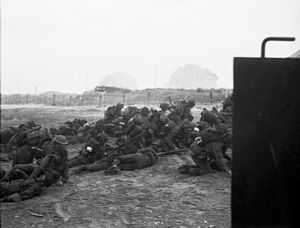9th Infantry Brigade (United Kingdom)
| 9th Infantry Brigade | |
|---|---|
| Country | United Kingdom |
| Branch | British Army |
| Type | Regular Infantry |
| Size | Brigade |
| Part of | 3rd Infantry Division |
| Commanders | |
| Notable commanders | Brian Horrocks |
| Insignia | |
| Identification symbol | Black Triangle with a smaller inverted Red Triangle inside |
The 9th Infantry Brigade was a Regular Army infantry brigade of the British Army that saw active service during both World War I and World War II.
History
World War I
During World War I, 9th Brigade's composition was as follows:[1]
- 1st Battalion, Northumberland Fusiliers
- 4th Battalion, Royal Fusiliers
- 1st Battalion, Lincolnshire Regiment (until November 1915)
- 1st Battalion, Royal Scots Fusiliers (until April 1916, then to 8th Brigade)
- 1/10th (Scottish) Battalion, King's (Liverpool Regiment) (from November 1914 to January 1916)
- 12th (Service) Battalion, West Yorkshire Regiment (from November 1915 to February 1918)
- 13th (Service) Battalion, King's (Liverpool Regiment) (joined from 8th Brigade in April 1916)
- 9th Brigade Machine Gun Company (formed in February 1916, joined the 3rd MG Battalion, Machine Gun Corps in March 1918)
- 9th Trench Mortar Battery (joined by May 1916)
The brigade served with the 3rd Division throughout the war, except for a brief a period in early 1915 when it exchanged places with the 85th Brigade of 28th Division.
World War II
The 9th Infantry Brigade together with 7th Infantry Brigade and 8th Infantry Brigade formed the 3rd Infantry Division. At the outbreak of World War II the division was commanded by Major-General Bernard Montgomery. With the 3rd Division the brigade was sent to France in October 1939, shortly after the outbreak of war, as part of the British Expeditionary Force, which evacuated from Dunkirk.
After the evacuation, the Brigade spent four years training in the UK, in preparation for an eventual assault landing in Europe.
The 3rd Division was the first British division to land at Sword Beach on D-Day and fought through the Battle of Normandy, the Netherlands and later the invasion of Germany.
During the often intense fighting from Sword Beach to Bremen, the Division suffered 2,586 killed.[2]
Brigade Units
- 2nd Battalion, Lincolnshire Regiment
- 1st Battalion, King's Own Scottish Borderers
- 2nd Battalion, Royal Ulster Rifles

Sword Beach
Sword Beach was the codename of one of the five main landing beaches in Operation Neptune, the initial assault phase of Operation Overlord, the Allied invasion of Normandy on 6 June 1944.
Stretching 8 kilometres (5.0 mi) from Ouistreham to Saint-Aubin-sur-Mer it was the furthest east of the landing points and around 15 kilometres (9.3 mi) from Caen. The landing site was divided into four zones - Oboe, Peter, Queen and Roger (west-east). The German defences consisted of beach obstacles, anti-tank ditches, mines, machineguns and mortars at the beaches and across the River Orne at Merville there were heavy guns. The defending troops belonged to the German 716th Static Infantry Division and could call on the support of the nearby 21st Panzer Division. The landing forces were the I Corps, comprising 3rd British Infantry Division and the 27th Armoured Brigade.
As well as being the furthest east of the landing beaches, Sword Beach was also the smallest, only wide enough for a brigade-sized landing force. 3rd British Division had the task of getting enough troops ashore to push inland quickly and seize Caen, and link up with 6th Airborne Division.
Sword Beach experienced the only counter-attack by the Germans on June 6. British troops had been unable to link up with the Canadians on Juno Beach, as had been planned and they were attacked by the 21st Panzer Division, who were veterans of the Western Desert Campaign. The 192nd Panzer Grenadier Regiment had reached Sword Beach by 2000 hours but were subject to aerial attacks and were destroyed by the Royal Air Force and the tanks of the 27th Armoured Brigade which had landed on Sword.
By the end of the day, 29,000 men had been landed at Sword with 630 casualties. Allied forces had advanced about four miles inland, the situation was stable and a link up with the Canadians on Juno had been established. However the major objective of Caen which was to have been captured on D Day still evaded them.
The Brigade went on to fight at Bourguebus Ridge, Mont Pincon, the Nederrijn, the Rhineland, and across the Rhine River.
References
- ↑ Baker, Chris. "The 3rd Division in 1914-1918". The Long, Long Trail. Retrieved 10 July 2014.
- ↑ Delaforce, Patrick (1995). Monty's Iron Sides. Stroud, Gloucestershire: Allan Sutton Publishing. p. 206. ISBN 0-7509-0781-9.